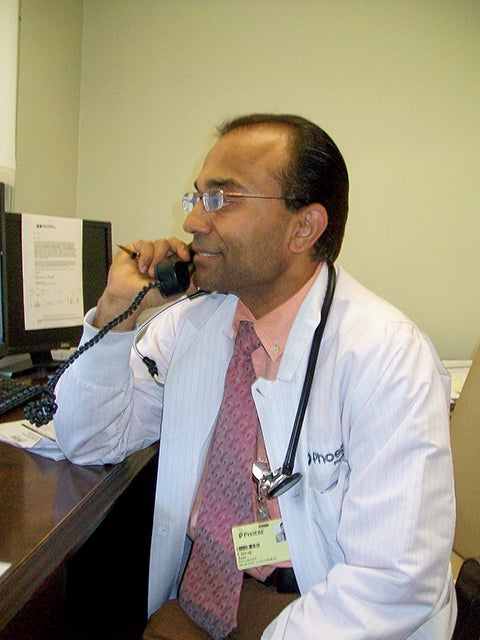Radical changes bring radical hope: the latest in breast cancer treatment
Published 9:30 am Monday, October 31, 2016

- Dr. Chirag Jani in his office at Phoebe Sumter Medical Center.
By JONI WOOLF
www.americustimesrecorder.com
AMERICUS — In the old days, which were not so very long ago, a woman discovering she had breast cancer was dependent on the judgment of one person to determine and control her treatment: her personal physician. She was not encouraged to ask questions. She certainly was not expected to question whatever course of treatment her doctor prescribed. She did what she was told. If a lump was found in her breast, the doctor said surgery was absolutely necessary, and if it was malignant, the breast would be removed, with the surgeon cutting under the arm and down the side, gathering skin to graft over the gaping concave space where once there was a breast. (This is how my physician explained the process to me, when a potential cancerous lump was found in my breast 50 years ago. Fortunately, the lump was benign.)
How things have changed. Just in the last few years, the concept of interdisciplinary treatment has burst on the scene, completely changing the way a woman faces breast cancer (still the leading cause of cancer in women). She is no longer alone. Rather, she has an entire team of physicians and other medical professionals holding her up, accompanying her on every step of her journey to wellness.
A recent interview with oncologist Dr. Chirag Jani, one of the physicians from Phoebe Putney who comes to Phoebe Sumter each week, was a refreshing and enlightening glance into the current state of breast cancer therapy. To begin with, Jani pointed out that the survival rate is increasing. He noted that 60 to 70 percent of breast cancers are found early, and they are almost always curable. Of the remaining percentage, life expectancy — even with advanced breast cancer — has increased dramatically with newer therapies.
The current approach to breast cancer, Jani said, is multi-disciplinary: a team that includes a medical oncologist, radiation oncologist, surgeon, social worker, genetic counselor, and a breast nurse navigator, work together — with the patient — to determine the best therapy and outcome for the individual patient. There is no longer a “one size fits all” mentality when it comes to treating breast cancer. Patients thrive under this model, Jani reports. He explains that the breast nurse navigator is with the patient as she goes into surgery, follows her out of surgery, and is with her throughout her stay in the hospital and her treatment. The patient is never left alone to wonder “what happens next?”
Obviously, this approach focuses on the emotional side of each person. But that does not mean that full attention is not being paid to the disease. The latest and certainly the least invasive treatment, immunotherapy, is administered in the form of a pill, not intravenously, and the results have been remarkable. Immunotherapy targets cancer cells and puts the patient’s own immune system to work in combatting the disease. Because of the effectiveness of immunotherapy in pill form, the incidence of intravenous chemotherapy has gone down 20 to 30 percent, Jani says. This newer therapy is, at core, personalized medicine, with every treatment program designed for a particular person. That person and her breast cancer treatment are discussed by the team of doctors and other health care professionals when they meet three times weekly at 7 a.m. They are serious about what they are doing, and they care deeply about their patients.
Treatment can be complicated, Jani says, but patients are thriving under this multi-disciplinary approach. In addition to the treatment team, a social worker is available for counseling and support in practical areas such as family support, financial concerns and social connections that are important to the patient.
Jani is an oncologist, so he treats many forms of cancer. Though lung cancer is the number one cancer found in men, breast cancer still ranks number one among women — and one in eight will have it during their lifetime. But strides are being made in all forms of cancer. Jani pointed out that the incidence of recurrence of colon cancer is reduced by 30 percent when aspirin therapy, as prescribed by the patient’s physician, is administered. Mortality rates are going down for several reasons: early detection, new and improved treatment, patients participating in their own health care.
Yes, survival rates are increasing. Treatment is being personalized, targeted to each woman’s individual needs. Jani made four important points about current understanding of cancer treatment: First of all, prevention is better than a cure; if we don’t all know that obesity is a contributing factor, we should. Keeping one’s weight at a safe level is something every person can do for their own health’s sake. Second, taking care of the patient, in totality, is vital (that includes physical, emotional and spiritual needs). Third, treatment follows diagnosis and being a participant in that treatment is something every patient is encouraged to do. Fourth, and of vital importance, is the need to understand that immunotherapy is changing the way cancer is treated. An informed patient is a patient who knows what she is up against, and fights — with the team of doctors and other health professionals — to protect her health, to understand what it will take to be well again — and bravely faces it.
Breast cancer is a terrifying diagnosis. But the probability of a full recovery is far greater than it has ever been. And with medical professionals like Dr. Chirag Jani investing their lives in the prevention and treatment of breast cancer, while looking for a cure, the future is bright indeed.





